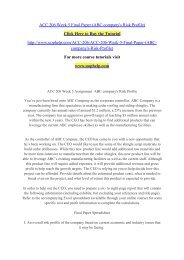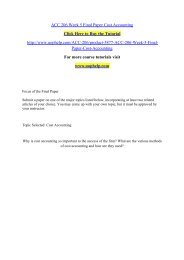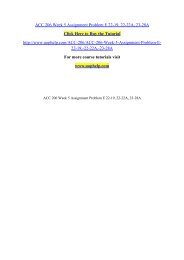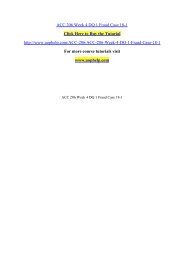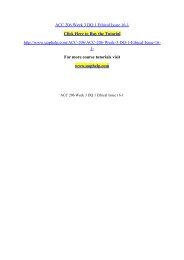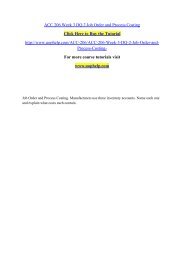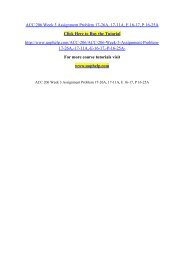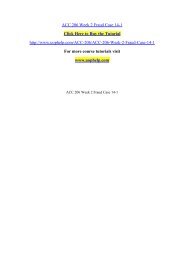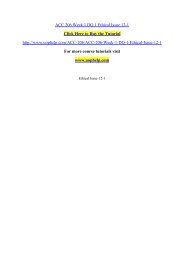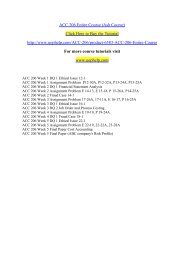ACC 205 Week 2 Exercise Assignment Revenue and Expenses/ UOPHELP
For more course tutorials visit www.uophelp.com 1. Recognition of concepts. Ron Carroll operates a small company that books entertainers for theaters, parties, conventions, and so forth. The company’s fiscal year ends on June 30. Consider the following items and classify each as either (1) prepaid expense, (2) unearned revenue, (3) accrued expense, (4) accrued revenue, or (5) none of the foregoing. a. Amounts paid on June 30 for a 1-year insurance policy b. Professional fees earned but not billed as of June 30 c. Repairs to the firm’s copy machine, incurred and paid in June d. An advance payment from a client for a performance next month at a convention e. The payment in part (d) from the client’s point of view f. Interest owed on the company’s bank loan, to be paid in early July g. The bank loan payable in part (f) h. Office supplies on hand at year-end
For more course tutorials visit
www.uophelp.com
1. Recognition of concepts. Ron Carroll operates a small company that books entertainers for theaters, parties, conventions, and so forth. The company’s fiscal year ends on June 30. Consider the following items and classify each as either (1) prepaid expense, (2) unearned revenue, (3) accrued expense, (4) accrued revenue, or (5) none of the foregoing.
a. Amounts paid on June 30 for a 1-year insurance policy
b. Professional fees earned but not billed as of June 30
c. Repairs to the firm’s copy machine, incurred and paid in June
d. An advance payment from a client for a performance next month at a convention
e. The payment in part (d) from the client’s point of view
f. Interest owed on the company’s bank loan, to be paid in early July
g. The bank loan payable in part (f)
h. Office supplies on hand at year-end
You also want an ePaper? Increase the reach of your titles
YUMPU automatically turns print PDFs into web optimized ePapers that Google loves.
<strong>ACC</strong> <strong>205</strong> <strong>Week</strong> 2 <strong>Exercise</strong> <strong>Assignment</strong> <strong>Revenue</strong> <strong>and</strong> <strong>Expenses</strong> (New)<br />
Click Here To Buy The Tutorial<br />
http://www.uophelp.com/<strong>ACC</strong>-<strong>205</strong>-(New)/product-10173-<strong>ACC</strong>-<strong>205</strong>-<strong>Week</strong>-2-<br />
<strong>Exercise</strong>-<strong>Assignment</strong>-<strong>Revenue</strong>-<strong>and</strong>-<strong>Expenses</strong>-(New)<br />
For more course tutorials visit<br />
www.uophelp.com<br />
1. Recognition of concepts. Ron Carroll operates a small company that books entertainers<br />
for theaters, parties, conventions, <strong>and</strong> so forth. The company’s fiscal year ends on June 30.<br />
Consider the following items <strong>and</strong> classify each as either (1) prepaid expense, (2) unearned<br />
revenue, (3) accrued expense, (4) accrued revenue, or (5) none of the foregoing.<br />
a. Amounts paid on June 30 for a 1-year insurance policy<br />
b. Professional fees earned but not billed as of June 30<br />
c. Repairs to the firm’s copy machine, incurred <strong>and</strong> paid in June<br />
d. An advance payment from a client for a performance next month at a convention<br />
e. The payment in part (d) from the client’s point of view<br />
f. Interest owed on the company’s bank loan, to be paid in early July<br />
g. The bank loan payable in part (f)<br />
h. Office supplies on h<strong>and</strong> at year-end<br />
2. Analysis of prepaid account balance. The following information relates to Action Sign<br />
Company for 20X2:<br />
Insurance expense<br />
$4,350<br />
Prepaid insurance, December 31, 20X2<br />
1,900
Cash outlays for insurance during 20X2<br />
6,200<br />
Compute the balance in the Prepaid Insurance account on January 1, 20X2.<br />
3. Underst<strong>and</strong>ing the closing process. Examine the following list of accounts:<br />
Interest Payable<br />
Accumulated Depreciation: Equipment<br />
Alex Kenzy, Drawing<br />
Accounts Payable<br />
Service <strong>Revenue</strong><br />
Cash<br />
Accounts Receivable<br />
Supplies Expense<br />
Interest Expense<br />
Which of the preceding accounts<br />
a. appear on a post-closing trial balance?<br />
b. are commonly known as temporary, or nominal, accounts?<br />
c. generate a debit to Income Summary in the closing process?<br />
d. are closed to the capital account in the closing process?<br />
4. Adjusting entries <strong>and</strong> financial statements. The following information pertains to<br />
Fixation Enterprises:<br />
The company previously collected $1,500 as an advance payment for services to be rendered<br />
in the future. By the end of December, one third of this amount had been earned.<br />
Fixation provided $2,500 of services to Artech Corporation; no billing had been made by<br />
December 31.
Salaries owed to employees at year-end amounted to $1,650.<br />
The Supplies account revealed a balance of $8,800, yet only $3,300 of supplies were actually<br />
on h<strong>and</strong> at the end of the period.<br />
The company paid $18,000 on October 1 of the current year to Vantage Property<br />
Management. The payment was for 6 months’ rent of Fixation’s headquarters, beginning on<br />
November 1.<br />
Fixation’s accounting year ends on December 31.<br />
Instructions<br />
Analyze the five preceding cases individually <strong>and</strong> determine the following:<br />
a. The type of adjusting entry needed at year-end (Use the following codes: A, adjustment of<br />
a prepaid expense; B, adjustment of an unearned revenue; C, adjustment to record an accrued<br />
expense; or D, adjustment to record an accrued revenue.)<br />
b. The year-end journal entry to adjust the accounts<br />
c. The income statement impact of each adjustment (e.g., increases total revenues by $500)<br />
5. Adjusting entries. You have been retained to examine the records of Kathy’s Day Care<br />
Center as of December 31, 20X3, the close of the current reporting period. In the course of<br />
your examination, you discover the following:<br />
On January 1, 20X3, the Supplies account had a balance of $2,350. During the year, $5,520<br />
worth of supplies was purchased, <strong>and</strong> a balance of $1,620 remained unused on December 31.<br />
Unrecorded interest owed to the centertotaled $275 as of December 31.<br />
All clients pay tuition in advance, <strong>and</strong> their payments are credited to the Unearned Tuition<br />
<strong>Revenue</strong> account. The account was credited for $75,500 on August 31. With the exception of<br />
$15,500 all amounts were for the current semester ending on December 31.<br />
Depreciation on the school’s van was $3,000 for the year.<br />
On August 1, the center began to pay rent in 6-month installments of $21,000. Kathy wrote a<br />
check to the owner of the building <strong>and</strong> recorded the check in Prepaid Rent, a new account.<br />
Two salaried employees earn $400 each for a 5-day week. The employees are paid every<br />
Friday, <strong>and</strong> December 31 falls on a Thursday.<br />
Kathy’s Day Care paid insurance premiums as follows, each time debiting Prepaid Insurance:<br />
Date Paid<br />
Policy No.<br />
Length of Policy<br />
Amount
Feb. 1, 20X2<br />
1033MCM19<br />
1 year<br />
$540<br />
Jan. 1, 20X3<br />
7952789HP<br />
1 year<br />
912<br />
Aug. 1, 20X3<br />
XQ943675ST<br />
2 years<br />
840<br />
Instructions<br />
The center’s accounts were last adjusted on December 31, 20X2. Prepare the adjusting entries<br />
necessary under the accrual basis of accounting.<br />
6. Bank reconciliation <strong>and</strong> entries. The following information was taken from the<br />
accounting records of Palmetto Company for the month of January:<br />
Balance per bank<br />
$6,150<br />
Balance per company records<br />
3,580<br />
Bank service charge for January<br />
20<br />
Deposits in transit<br />
940<br />
Interest on note collected by bank<br />
100<br />
Note collected by bank<br />
1,000
NSF check returned by the bank with the bank statement<br />
650<br />
Outst<strong>and</strong>ing checks<br />
3,080<br />
Instructions:<br />
a. Prepare Palmetto’s January bank reconciliation.<br />
b. Prepare any necessary journal entries for Palmetto.<br />
7. Direct write-off method. Harrisburg Company, which began business in early 20X7,<br />
reported $40,000 of accounts receivable on the December 31, 20X7, balance sheet. Included<br />
in this amount was $550 for a sale made to Tom Mattingly in July. On January 4, 20X8, the<br />
company learned that Mattingly had filed for personal bankruptcy. Harrisburg uses the direct<br />
write-off method to account for uncollectibles.<br />
a. Prepare the journal entry needed to write off Mattingly’s account.<br />
b. Comment on the ability of the direct write-off method to value receivables on the year-end<br />
balance sheet.<br />
8. Allowance method: estimation <strong>and</strong> balance sheet disclosure. The following pre-adjusted<br />
information for the Maverick Company is available on December 31:<br />
Accounts receivable $107,000<br />
Allowance for uncollectible accounts 5,400 (credit balance)<br />
Credit sales 250,000<br />
a. Prepare the journal entries necessary to record Maverick’s uncollectible accounts expense<br />
under each of the following assumptions:<br />
(1) Uncollectible accounts are estimated to be 5% of Credit Sales.<br />
(2) Uncollectible accounts are estimated to be 14% of Accounts Receivable.<br />
b. How would Maverick’s Accounts Receivable appear on the December 31 balance sheet<br />
under assumption (1) of part (a)?<br />
c. How would Maverick’s Accounts Receivable appear on the December 31 balance sheet<br />
under assumption (2) of part (a)?
9. Direct write-off <strong>and</strong> allowance methods: matching approach. The December 31, 20X2,<br />
year-end trial balance of Targa Company revealed the following account information:<br />
Debits<br />
Credits<br />
Accounts Receivable<br />
$252,000<br />
Allowance for Uncollectible Accounts<br />
$ 3,000<br />
Sales<br />
855,000<br />
Instructions<br />
a. Determine the adjusting entry for bad debts under each of the following conditions:<br />
(1) An aging schedule indicates that $12,420 of accounts receivable will be uncollectible.<br />
(2) Uncollectible accounts are estimated at 2% of net sales.<br />
b. On January 19, 20X3, Targa learned that House Company, a customer, had declared<br />
bankruptcy. Present the proper entry to write off House’s $950 balance using the allowance<br />
method.<br />
c. Repeat the requirement in part (b), using the direct write-off method.<br />
d. In light of the House bankruptcy, examine the allowance <strong>and</strong> direct write-off methods in<br />
terms of their ability to properly match revenues <strong>and</strong> expenses.<br />
10. Allowance method: analysis of receivables. At a January 20X2 meeting, the president of<br />
Sonic Sound directed the sales staff “to move some product this year.” The president noted<br />
that the credit evaluation department was being disb<strong>and</strong>ed because it had restricted the<br />
company’s growth. Credit decisions would now be made by the sales staff.<br />
By the end of the year, Sonic had generated significant gains in sales, <strong>and</strong> the president was<br />
very pleased. The following data were provided by the accounting department:<br />
20X2<br />
20X1
Sales<br />
$23,987,000<br />
$8,423,000<br />
Accounts Receivable, 12/31<br />
12,444,000<br />
1,056,000<br />
Allowance for Uncollectible Accounts, 12/31<br />
?<br />
23,000 cr.<br />
The $12,444,000 receivables balance was aged as follows:<br />
Age of Receivable<br />
Amount<br />
Percentage of Accounts Expected to Be Collected<br />
Under 31 days<br />
$5,321,000<br />
99%<br />
31260 days<br />
3,890,000<br />
90<br />
61290 days<br />
1,067,000<br />
80<br />
Over 90 days<br />
2,166,000<br />
60<br />
Assume that no accounts were written off during 20X2.<br />
Instructions
a. Estimate the amount of Uncollectible Accounts as of December 31, 20X2.<br />
b. What is the company’s Uncollectible Accounts expense for 20X2?<br />
c. Compute the net realizable value of Accounts Receivable at the end of 20X1 <strong>and</strong> 20X2.<br />
d. Compute the net realizable value at the end of 20X1 <strong>and</strong> 20X2 as a percentage of<br />
respective year-end receivables balances. Analyze your findings <strong>and</strong> comment on the<br />
president’s decision to close the credit evaluation department.



